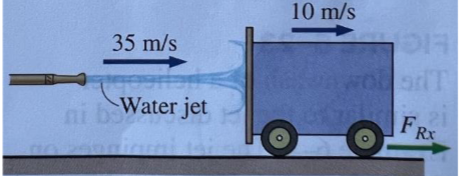Water accelerated by a nozzle to 35 m/s strikes the verticalback surface of a cart moving horizontally at a constant velocity of 10 m/s in the flow direction as shown in Fig. Q5.The mass flow rate of water through the stationary nozzle is 30 kg/s. After the strike, the water stream splatters off in all direction in the plane of the back surface. (i) State Newton’s second law of motion and determine theforce that needs to be applied by the brakes of the cart toprevent it from accelerating. (ii) If the force were used to generate power instead of wasting it on the brakes, determine the maximum amount of power that could ideally be generated. (iii) If the mass of the cart is 400 kg and the brakes fail,determine the acceleration of the cart when the water firststrikes it. Assume the mass of water that wet the back surface is negligible
Water accelerated by a nozzle to 35 m/s strikes the verticalback surface of a cart moving horizontally at a constant velocity of 10 m/s in the flow direction as shown in Fig. Q5.The mass flow rate of water through the stationary nozzle is 30 kg/s. After the strike, the water stream splatters off in all direction in the plane of the back surface.
(i) State Newton’s second law of motion and determine theforce that needs to be applied by the brakes of the cart toprevent it from accelerating.
(ii) If the force were used to generate power instead of wasting it on the brakes, determine the maximum amount of power that could ideally be generated.
(iii) If the mass of the cart is 400 kg and the brakes fail,determine the acceleration of the cart when the water firststrikes it. Assume the mass of water that wet the back surface is negligible

Step by step
Solved in 3 steps with 7 images




